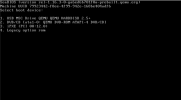I just wanted to say Huge Thanks in particular to
@PanWaclaw,
@gfngfn256 and
@Mirmanium.
Indeed without using XHCI it took AGES to install Debian 12 on the USB Image.
After switching to XHCI, it's super Fast

.
I tried to collect the Information and put it into a somewhat easy to use Script to attach/detach Virtual USB Flashdrive from a VM.
You can find it here:
https://github.com/luckylinux/pve-scripts/blob/main/configure_virtual_usb_flashdrive.sh
The "Trick" is to add
bootindex=0 at the end of the
-args Command Line is what makes the System boot from USB, since it's NOT possible to configure boot the "normal" Way (by setting
boot: order=usb0;sata0;ide0 or something along these Lines)
If you do NOT add
bootindex=0 to the
-args, it's still possible to boot to USB, but that will NOT occur automatically.
You must in such Case act fast in the Console by continuosly pressing ESC as soon as the VM is started, and then selecting the right Device (which IMHO is not always so easy to recognize, although with XHCI Driver it's correctly recognized as USB MSC Drive QEMU QEMU HARDDISK 2.5+):

It's also possible to add a
,serial=0123456789 (or whatever Serial Number you desire) before the
,bootindex=0 Directive in case you want to easily recognize the Device after Boot:
Code:
root@liveusb-proxmox:~# ls -l /dev/disk/by-id/
total 0
lrwxrwxrwx 1 root root 9 Apr 6 14:30 ata-QEMU_DVD-ROM_QM00003 -> ../../sr0
lrwxrwxrwx 1 root root 9 Apr 6 14:30 scsi-0QEMU_QEMU_HARDDISK_drive-scsi0 -> ../../sda
lrwxrwxrwx 1 root root 9 Apr 6 14:30 usb-QEMU_QEMU_HARDDISK_0123456789-0:0 -> ../../sdb
lrwxrwxrwx 1 root root 10 Apr 6 14:30 usb-QEMU_QEMU_HARDDISK_0123456789-0:0-part1 -> ../../sdb1
lrwxrwxrwx 1 root root 10 Apr 6 14:30 usb-QEMU_QEMU_HARDDISK_0123456789-0:0-part2 -> ../../sdb2
lrwxrwxrwx 1 root root 10 Apr 6 14:30 usb-QEMU_QEMU_HARDDISK_0123456789-0:0-part3 -> ../../sdb3
And this is how lsusb Output looks:
Code:
root@liveusb-proxmox:~# lsusb
Bus 003 Device 002: ID 46f4:0001 QEMU QEMU USB HARDDRIVE
Bus 003 Device 001: ID 1d6b:0003 Linux Foundation 3.0 root hub
Bus 001 Device 001: ID 1d6b:0002 Linux Foundation 2.0 root hub
Bus 002 Device 002: ID 0627:0001 Adomax Technology Co., Ltd QEMU Tablet
Bus 002 Device 001: ID 1d6b:0001 Linux Foundation 1.1 root hub
root@liveusb-proxmox:~# lsusb -d 46f4:0001 -vvv
Bus 003 Device 002: ID 46f4:0001 QEMU QEMU USB HARDDRIVE
Device Descriptor:
bLength 18
bDescriptorType 1
bcdUSB 3.00
bDeviceClass 0
bDeviceSubClass 0
bDeviceProtocol 0
bMaxPacketSize0 9
idVendor 0x46f4 QEMU
idProduct 0x0001
bcdDevice 0.00
iManufacturer 1 QEMU
iProduct 2 QEMU USB HARDDRIVE
iSerial 3 0123456789
bNumConfigurations 1
Configuration Descriptor:
bLength 9
bDescriptorType 2
wTotalLength 0x002c
bNumInterfaces 1
bConfigurationValue 1
iConfiguration 6 Super speed config (usb 3.0)
bmAttributes 0xc0
Self Powered
MaxPower 0mA
Interface Descriptor:
bLength 9
bDescriptorType 4
bInterfaceNumber 0
bAlternateSetting 0
bNumEndpoints 2
bInterfaceClass 8 Mass Storage
bInterfaceSubClass 6 SCSI
bInterfaceProtocol 80 Bulk-Only
iInterface 0
Endpoint Descriptor:
bLength 7
bDescriptorType 5
bEndpointAddress 0x81 EP 1 IN
bmAttributes 2
Transfer Type Bulk
Synch Type None
Usage Type Data
wMaxPacketSize 0x0400 1x 1024 bytes
bInterval 0
bMaxBurst 15
Endpoint Descriptor:
bLength 7
bDescriptorType 5
bEndpointAddress 0x02 EP 2 OUT
bmAttributes 2
Transfer Type Bulk
Synch Type None
Usage Type Data
wMaxPacketSize 0x0400 1x 1024 bytes
bInterval 0
bMaxBurst 15
Binary Object Store Descriptor:
bLength 5
bDescriptorType 15
wTotalLength 0x0016
bNumDeviceCaps 2
USB 2.0 Extension Device Capability:
bLength 7
bDescriptorType 16
bDevCapabilityType 2
bmAttributes 0x00000002
HIRD Link Power Management (LPM) Supported
SuperSpeed USB Device Capability:
bLength 10
bDescriptorType 16
bDevCapabilityType 3
bmAttributes 0x00
wSpeedsSupported 0x000e
Device can operate at Full Speed (12Mbps)
Device can operate at High Speed (480Mbps)
Device can operate at SuperSpeed (5Gbps)
bFunctionalitySupport 1
Lowest fully-functional device speed is Full Speed (12Mbps)
bU1DevExitLat 10 micro seconds
bU2DevExitLat 32 micro seconds
can't get debug descriptor: Resource temporarily unavailable
Device Status: 0x0001
Self Powered
EDIT 1:
Usage Instructions:
Code:
./configure_virtual_usb_flashdrive.sh attach <vmid> <path_to_img_file>
./configure_virtual_usb_flashdrive.sh detach <vmid> <path_to_img_file>
Usage Example:
Code:
./configure_virtual_usb_flashdrive.sh attach 99999004 /var/lib/usbimages/Debian_From_Scratch.img
./configure_virtual_usb_flashdrive.sh detach 99999004 /var/lib/usbimages/Debian_From_Scratch.img
I had Issues booting my existing Physical LiveUSB that I imaged using
dd, probably because back then (6 Years ago ?) when it was created, it was probably NOT propertly aligned to 4MiB etc.
That's what I could understand at least from this Post here, which matched the Error I was getting:
https://forum.proxmox.com/threads/l...ot-get-write-permission-without-resize.89891/.
Hence why the Image is named
Debian_From_Scratch.img 
.
EDIT 2: fixed Formatting. Backtick habit from GitHub not working here for Code Snippets

.
EDIT 3: Note that I only briefly tested this. I added a check to shutdown the VM if trying to detach the Virtual USB Flashdrive (because I am assuming that you booted from that Drive and NOT the HDD/CD-ROM) as well as a Convenience
Do you want to [re]start the VM and boot into LiveUSB ? Message + Action depending on User Input.
I did NOT cover all edge Cases etc. If you have existing settings in
args, it
should preserve them, and only add (when attaching) or strip away (when detaching) the Settings defined in the
drive_str Line.
EDIT 4: to be clear, if you are also getting the Error that I was getting described at the end of (EDIT 1), you cannot use the Physical USB Drive and Image it to build a Virtual USB Drive. Or at least you must fix the Alignment first.
I thought it would take less Time to just create an Empty Virtual Disk with
dd, mount a Debian 12 AMD64 ISO as CD-ROM and the (currently empty) USB Virtual Drive Image in a VM, then just perform the Installation as Usual (I personally make sure that I setup BOTH a BIOS/GRUB Partition + EFI FAT32 Partition + "/" EXT4 Partition and Optionally a separate /boot and Swap, although the latter 2 shouldn't be needed in normal Circumstances).
So I just created a 32GB empty Virtual Drive and run the Installer from within the VM

:
Code:
dd bs=1G count=32 if=/dev/zero of=/var/lib/usbimages/Debian_From_Scratch.img


